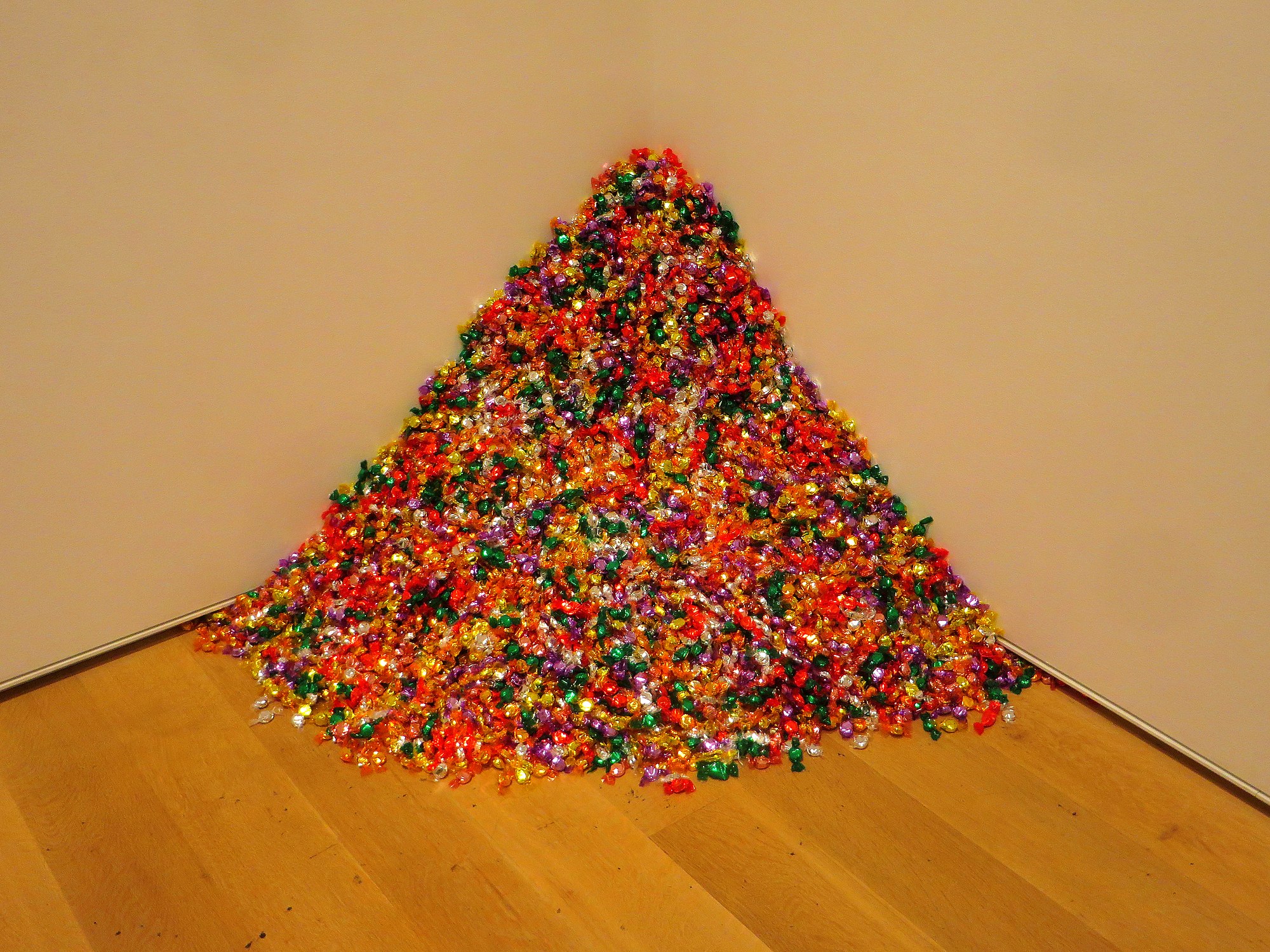Félix González-Torres Outline
FÉLIX GONZÁLEZ-TORRES
(November 26, 1957-January 9, 1996)
Intro
• Cuban born American visual artist (born in Guáimaro, Cuba)
• openly gay sexual orientation often seen as influential in his work
• sent to an orphanage in Madrid, Spain as a young boy
• later relocated to Puerto Rico in 1957
• graduated from Colegio San George in 1976 and began art Studies at University of Puerto Rico in 1976
• moved to New York City in 1979 with a study fellowship
• participated in the Whitney independent study program in 1980
• attended the program again in 1983 and received a BFA in photography from the Pratt Institute of Art
• traveled to Europe and studied in Venice in 1986
• awarded the degree of Master of Fine Arts by the International Center of Photography and New York University in 1987
• in the same year joined a New York-based group of artist called Group Material
• worked collaboratively adhering to principles of cultural activism and community education
• taught at New York university and the California Institute of the Arts
• granted a DAAD fellowship to work in Berlin in 1992, and a fellowship from the National Endowment for the Arts in 1993
Most Important Work
Untitled (Loverboy) c. 1989
~ consists of two sets of gauzy light blue curtains hanging in front of open windows.
~ French windows and curtains
~ windowpane's grids immediately recalls similar forms in early twentieth-century paintings
~ visual representation of unseen, absent forces
~ open windows further suggest a sudden or unplanned exit
~ foreshadowing the loss of the artist's longtime partner, Ross Laycock, who was living with AIDS.
~ reminders of human habitation in a space that is otherwise left empty
Untitled (Portrait of Ross in L.A.) c. 1990
~ endlessly renewable pile of individually wrapped candies with an "ideal" total weight of 175 lbs.
~ candies wrapped in blu, sliver, and red cellophane
~ number that corresponds to his partner Ross's healthy weight (before he contracted HIV)
~ diminish as visitors take candy from the pile, and are then replenished.
~ representative as cycle of life and death.
~ spills were considered portraits
~ forms suggested by some aspect of a person
~ weight, color, or to other personal associations the artist made
Untitled (Petit Palais) c. 1992
~ two intertwining strands of bulbs
~ Light bulbs, porcelain light sockets and extension cords
~ "I don't necessarily know how these pieces are best displayed. I don't have all of the answers - you [the owner] decide how you want it done. Whatever you want to do, try it. This is not some Minimalist artwork that has to be exactly two inches to the left and six inches down. Play with it, please. Have fun. Give yourself that freedom. Put my creativity into question..."
Untitled (Go-Go Dancing Platform) c. 1991
~ must wear silver lamé bikini, sneakers, and personal listening device
~ addition of a living human invests the formal movement
~ blatantly homoerotic moment to the space of the museum, where scenes of heterosexual desire are typically dominant.
Untitled (Water) c. 1995
~ luminous, blue-beaded curtain
~ luminosity, movement, and therapeutic qualities of water
~ repeated in a specific sequence of blue, clear and silver strands
~ elongated to fill the given doorway of an exhibition space
~ momentarily “cleansed” of concerns and distractions
~ pleasurable and celebratory sensations can be found in common objects.
Summary
• minimal installations• sculptures
• simplicity
• affective impact
• used materials such as strings of light bulbs, clocks, stacks of papers, packaged or hard candies.
• majority of works are entitled “untitled”
• utilized a system of parenthetic titles that directed the viewer towards physical or personal associations the artist had with various subjects
• drew inspiration from traditions of minimalism and conceptual art
• created installations and sculptures that function as personal and political meditations on private and public life
• focused on ideas of formation and decay
• public interactivity was an integral part of some of his most iconic pieces
• utilized household objects that have the potential to change over time
• combined them with enduring materials such as puzzles, light bulb strings, and photographs
• work often referred to as process art
• emphasized thematic universality of his pieces
• Wanted work to be widely disseminated and believed it was not fully realized without the participation of the viewer
• transformed mundane objects into installations that allowed visitors to take these objects with them after they left the exhibit
• brought personal history and politics to contemporary Art
• works referenced current events such as gay rights, gun violence, and the AIDS crisis from which he suffered from until his death in 1996
Bibliography
> "Felix Gonzalez-Torres
American Conceptual, Post-Minimalist and Relational Aesthetics Artist"
> http://www.theartstory.org/artist-gonzalez-torres-felix.htm
> http://images.andrearosengallery.com/www_andrearosengallery_com/1991crivtrEX2_200c_lr3.jpg
> http://www.16miles.com/2009/01/flix-gonzlez-torres-and-go-go-dancers.html
> http://www.andrearosengallery.com/artists/felix-gonzalez-torres> http://blog.artbma.org/tag/felix-gonzalez-torres/
> https://worleygig.com/2017/01/26/felix-gonzalez-torres-untitled-water-at-the-brooklyn-museum/
> https://i.pinimg.com/originals/94/05/ed/9405ed35dc724594c985199a93cf4ce3.jpg
> https://www.sartle.com/sites/default/files/images/artwork/candy_b.jpg
>http://www.artealdia.com/var/artealdia_com/storage/images/international/contenidos/artistas/fe_lix_gonza_lez-torres/felix2/381837-1-esl-AR/felix2_full.png
> https://i.pinimg.com/originals/95/b4/aa/95b4aafead332bc7a79c8aaddc77fed8.jpg
> https://www.guggenheim.org/artwork/artist/felix-gonzalez-torres



Comments
Post a Comment